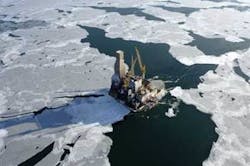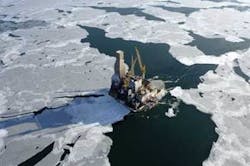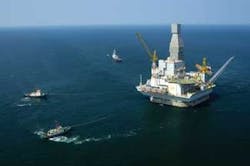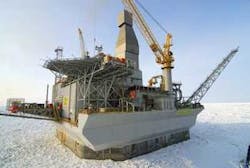Boris Zuskov, Paul Vande Zande, Anthony M. Higgins, ExxonMobil Development Co.
null
The drilling and operating environment offshore Sakhalin Island is one of the most challenging in the world. The combination of extreme weather, ice-packed conditions, remote location, and complex extended reach drilling (ERD) objectives, demands a highly specialized drill- ing and production installation.
Aerial view of the Orlan platform surrounded by ice in the Sea of Okhotsk offshore Sakhalin Island, Russia. (Photo courtesy of ExxonMobil Corp.)
In 2001, ExxonMobil subsidiary Exxon Neftegas Ltd. (ENL) acquired the concrete island drilling structure (CIDS) from Global Marine Drilling Co. The platform had been operating intermittently in the arctic water offshore Alaska for 12 years, followed by a three-year period of inactivity from 1998. Over a four-year period beginning in 2001, the facility was converted into the Orlan fixed drilling and production platform for use on the ExxonMobil-operated Sakhalin-1 project.
Original specifications
The original CIDS was a mobile offshore drilling unit built for Global Marine Development Inc. in the early 1980s. It was designed and fabricated at the Nippon Kokan K.K. shipyard in Japan. In 1984, the platform was delivered to the Beaufort Sea in Alaska to drill shallow-water exploration and appraisal wells.
CIDS was designed specifically for drilling in harsh arctic offshore conditions in water depths from 35 to 50 ft (11-15 m). Its robust, highly mobile design offered both economic and environmental advantages over the manmade gravel islands that were commonly used in Alaskan waters. The structure was constructed such that it could be towed to a drill site and ballasted with seawater, then deballasted, refloated, and moved quickly to another drilling location. The primary structural components of the platform were a steel mudbase, concrete center structure (“brick”), two steel deck storage barges, drilling, and accommodation modules.
Transit to Russia
CIDS was stacked at BP Exploration’s Northstar project in Prudhoe Bay, Alaska, after it was acquired by ENL. The new owner hired Crowley Marine Services to move the structure from Alaska to Sovietskaya Gavan in Russia for conversion.
Tugs guide the Orlan platform into place in the Chayvo field in the Sea of Okhotsk. (Photo courtesy of ExxonMobil Corp.)
The transit team arrived in Alaska in early Aug. 2001 to begin the sealift process. Once conditions were deemed safe for transport, CIDS was towed by two Crowley 7,200 bhp twin-screw oceangoing tugs, theSea Victory and the Sea Venture. Ice was managed ahead of the tow by a 23,200 bhp ice-breaker tug, the Arctic Kalvik.
The seven-week journey across the Bering Sea to the Russian Pacific coast covered approximately 4,800 km (2,983 mi). CIDS reached the Sovietskaya Gavan harbor in Russian waters and cleared customs on Oct. 14, 2001. From there, Amur Shipbuilding Plant (ASP) carried out the engineering, procurement, construction, and installation of the facility’s components. ASP worked alongside Hyundai Heavy Industries (HHI), Natchiq, and others.
CIDS modifications
Converting the mobile CIDS drilling system to the fixed Orlan drilling and production platform required multiple structural and functional upgrades. ASP carried out work on the unit’s mudbase, brick, deck storage barges, and drilling and accommodation modules.
The mudbase was reinforced and modified to accommodate two new internal riser shafts. Two 2.8-m (9.2-ft) diameter openings had to be cut in the surface of the unit’s top deck to allow the risers to pass through the structure. Holes also were made in the mudbase wing tanks. The tanks were resealed and kept watertight.
ASP built and installed a conductor guide frame in the mudbase moonpool to maintain the spacing needed for the 20 planned 30-in. (76-cm) conductors at the seabed. The mudbase also was fitted with a cathodic system for long-term protection from corrosion.
Modifications to the platform’s concrete brick allowed it to accommodate the new riser shafts. Two 3.2-m (10.5-ft) openings were cut through the top and bottom layers of the pre-stressed concrete for insertion of two 2.8-m (9.2-m) steel riser shaft extensions. Piping modifications to the sea chests and equalizing lines were part of the seawater lift system upgrade. The lift system supports drilling and cuttings reinjection and disposal operations.
Above the water line, major modifications to the structure’s deck barge were required to handle the anticipated harsh wave and ice conditions offshore Sakhalin Island. ASP removed and reframed the port barge corner rakes and a portion of the port and replaced them with smaller ones to preserve consistency with the rest of the structure. These were partially filled with concrete for strength and stability. Shear pins and steel plating were added to increase the structure’s lateral resistance to wave and seismic loads. The barge bulkheads and portions of the main and bottom deck scantlings also were reinforced to withstand wave and seismic forces, and to support the substantially larger drilling unit.
Wave deflectors were added 4 m (13 ft) high to the forward, port, and aft deck barges (windward sides). A continuous steel skirting was installed around the perimeter of the brick barge interface to manage water intrusion and potential freeze impact to the interface between the components. Flexible sealant was applied to fill the voids in and around the steel skirting.
ASP also enlarged the main deck opening at the moonpool to match the size of the hole in the brick and mudbase to accommodate the new conductors. The lower deck level and all access ladders and conductor guides were replaced by new access points. The deck barges then were connected, after which, top and bottom deck plating and transverse frames were added to minimize the differential impact of wave loads.
Next, ASP locally strengthened a variety of deck-level girders, secondary steelwork, and weldments, and made watertight most non-watertight bulkheads to accommodate fuel, drill water, and seawater storage. The tank, barge, and brick heating systems were upgraded for freeze protection, and a zero discharge deck drainage and curbing system was installed.
Drilling/accommodation upgrades
ASP removed and replaced the platform’s existing drilling rig with a new one capable of drilling 3D ERD wells in remote, sub-arctic conditions. KCA Deutag designed the drilling package. The modular package was built by HHI in Korea.
Orlan’s upgraded topdrive system handles a 5 7/8-in. drillstring for drilling 3D ERD wells. The drillfloor levels contain the tubular handling equipment and the circulating, cementing, and drilling control systems. The rig’s substructure transfers the drilling loads to the skid base, and the lower deck levels house the BOP, HVAC, and trip tank systems. The skid base extends along the roof of the wellbay, capable of moving across the 20 conductor slot locations. The skidding system uses two 425-ton (386-metric ton) jacks to move north-south and two 425-ton (386-metric ton) jacks to move east-west. Drag chains follow the two skidding directions with electrical and instrumentation cables and service lines.
The platform has three drilling modules: DSM-1, DSM-2, and DSM-3. DSM-1 contains the glycol and steam boilers, HVAC plant, diesel generators (five each at 2.3 MW), electrical switch rooms, air compressor packages, storage/lay-down areas, and a new platform crane.
DSM-2 contains the emergency generator, CRI package, firewater and seawater pumps, mud pumps and mud cleaning equipment, active and reserve mud tanks, and storage areas.
DSM-3 contains the pipe barn and catwalk area, mud/chemical mixing packages, scalping shaker and centrifuge room, and the primary sack storage area.
The rig’s entire electrical system was modified from 60 Hz to 50 Hz to ensure IEC compliance. Fire and gas detection, HVAC, and drilling ESD systems were installed as well. All drilling levels including the derrick are enclosed and winterized for year-round operations.
The platform is fitted with mud storage modules, MSM-1 and MSM-2, which provide bulk material storage, and 10 individual liquid storage tanks for non-aqueous and water-based fluids and cuttings. The modules have 1,200 cu m (42,378 cu ft) of total fluid capacity. The tanks are manifolded and contain mix and transfer pumps for flexibility. The modules also accommodate 600 cu m (21,189 cu ft) of bulk material storage in nine p-tanks, the bulk air compression, and drying systems. MSM-1 has an annex for cementing jobs, high-pressure testing, and backup CR1 pumping.
Orlan’s production module is configured with manifolds to handle 20 oil production, gas injection, and cutting injection wells. The initial phase of the Sakhalin-1 development called for 16 oil producers, three gas injectors, and one cuttings injector well.
The Orlan platform, with work areas enclosed and heated for winter, is surrounded by packed ice 3-5 ft (1-1.5 m) thick. (Photo courtesy of ExxonMobil Corp.)
Orlan will have no fluids processing capacity. Instead, the wellstream will be gathered in a production manifold and sent directly to an export manifold. A test header directs the wellstream to a test separator where the liquid and gas flow can be measured independently. High-pressure injection gas from the onshore facility is redistributed to individual gas injection wells via a gas injection header.
A cold vent system is installed to handle injection gases during shutdown. A second vent handles wet or warm gases relieved during processing. A closed, hazardous drain system disposes directly to a vent scrubber, and separated liquids are pumped into the export manifold. Methanol injection systems are used for hydrate management and start-up contingency.
A pig launcher (for the well fluid export line) and a pig receiver (for the injection gas line) are in place. The pig receiver can be reversed and converted to a launcher in the future to deliver low pressure multi-phase production to shore. The unit’s accommodation module was refurbished to house 120 people. The redesigned module also has office space, dining, kitchen, laundry, medical, and recreational facilities. One ice breaking supply vessel (IBSV) and two supply/support vessels are used to deliver equipment and supplies to Orlan. The roundtrip delivery time between the shore base and the platform ranges from 10 to 17 days, depending on the season and ice conditions. During the ice season (December to May), one IBSV is required to remain on site full time for ice management and emergency evacuation and rescue response. This strategy, combined with the rig’s 90-day storage capacity, allows for sustained drilling year round.
Orlan delivered
The upgraded Orlan drilling and production platform is designed to operate for 45 years in an offshore, sub-arctic environment between -35° C and +35° C (-31° and 95° F). The platform’s seismic design is based on a 200-year return period strength level earthquake with a predominantly elastic response that mitigates potential damage to the structure and its facilities. The ductility level earthquake (DLE) return period for the design is 3,000 years with an inelastic response expected. This prevents discharge to the environment, danger to onboard personnel, and structural collapse. A DLE event likely would require shutdown to inspect the platform and to make any needed structural repairs.
In July 2004, the partially converted structure was towed to Ulsan, Korea, where it was integrated with the rig and topside modules. HHI completed the drilling rig and topside module fabrication and subsequent installation on the Orlan platform in early 2005. The facility arrived at its final deployment location on July 12, 2005. Final commissioning and integration testing was performed on site.
The first well (OD-1, CRI) from Orlan was spudded on Dec. 8, 2005.
To date, five ERD wells have been completed on the Chayvo field offshore Sakhalin Island from the platform, the longest being 7.5 km (3.7 mi). The Sahkalin-1 project delivered first production in Oct. 2005.






